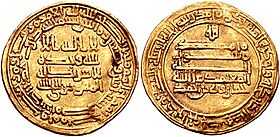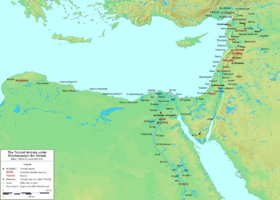Khumarawayh ibn Ahmad ibn Tulun facts for kids
Quick facts for kids Khumarawayh ibn Ahmad ibn Tulun |
|
|---|---|
| Ruler of Egypt and Syria | |

Gold dinar of Khumarawayh, minted in 885/6 CE and bearing the names of Caliph al-Mu'tamid, al-Mufawwad, and al-Muwaffaq
|
|
| Rule | 10 May 884 – 18 January 896 |
| Predecessor | Ahmad ibn Tulun |
| Successor | Jaysh ibn Khumarawayh |
| Born | 864 Samarra |
| Died | 18 January 896 al-Qata'i |
| Dynasty | Tulunid dynasty |
| Father | Ahmad ibn Tulun |
| Religion | Sunni Islam |
Khumarawayh ibn Ahmad ibn Tulun (born 864, died 896) was an important ruler in ancient Egypt and Syria. He was the son of Ahmad ibn Tulun, who founded the Tulunid dynasty. When his father passed away in 884, Khumarawayh took over as ruler. He successfully defended his power and made a deal with the Abbasid Caliphate in 886. This deal allowed him to rule Egypt and Syria, and his family could inherit the position. Later, in 893, he made an even stronger agreement with the new Caliph, al-Mu'tadid. To seal this important deal, his daughter Qatr al-Nada married the Caliph.
Khumarawayh's kingdom grew very large. It stretched from the Byzantine Empire's border all the way to Nubia. However, he spent a lot of money on fancy palaces and gifts for artists and poets. He also needed to pay his large army well to keep them loyal. This spending quickly emptied his treasury. Khumarawayh was killed in 896 by a palace servant. His son, Jaysh ibn Khumarawayh, ruled for only a few months before another son, Harun ibn Khumarawayh, took over. After Khumarawayh's death, the Tulunid state became weak. The Abbasids eventually took back control in 904–905.
Contents
Khumarawayh's Early Life and Family
Khumarawayh was born in Samarra in 864. His father, Ahmad ibn Tulun, was the son of a Turkish soldier. Ahmad ibn Tulun became the governor of Egypt in 868. In 871, he took control of Egypt's money. He used this money to build his own army of slave soldiers, called ghilmān.
His father used this strong army to gain power. He took control of Syria and the border areas with the Byzantine Empire. He also controlled parts of the Jazira region.
Becoming the Next Ruler
In 882, Khumarawayh's older brother, Abbas, rebelled against their father. Abbas was seen as cruel and untrustworthy. After this rebellion failed, Khumarawayh was chosen as his father's helper in Egypt. He was also named the next ruler.
His father confirmed this choice just before he died in May 884. Khumarawayh became ruler smoothly because he had the support of the Tulunid leaders. This was a big step in the Abbasid Caliphate losing its power. It was the first time a ruler's son openly inherited such a large territory.
Ruling the Kingdom
When Khumarawayh became ruler, he was young and new to the job. Some Abbasid leaders tried to take back control of the Tulunid lands. Generals Ishaq ibn Kundaj and Ibn Abi'l-Saj attacked Syria. They took Damascus when its governor switched sides. But their gains were quickly lost.
In 885, the Caliph's son, Abu'l-Abbas, led an invasion. He defeated the Tulunids and pushed them back to Palestine. But then, Abu'l-Abbas had a fight with his generals. They left the campaign.
The Battle of Tawahin
At the Battle of Tawahin on April 6, Khumarawayh fought Abu'l-Abbas himself. At first, Abu'l-Abbas was winning, and Khumarawayh had to flee. But then, the Tulunid general Sa'd al-Aysar defeated Abu'l-Abbas. Many of Abu'l-Abbas's soldiers were captured.
Afterward, al-Aysar tried to rebel in Damascus. But Khumarawayh quickly stopped him. It is said that Khumarawayh killed the rebel with his own hands.
Making Peace with the Caliphate
Khumarawayh wanted to make peace with the Abbasid court. He treated the captured soldiers from Tawahin very kindly. He let them choose to stay in Egypt and work for him, or go back to Iraq without paying a ransom.
This kind act led to an agreement in December 886. Khumarawayh was recognized as the governor of Egypt and Syria. His children could also inherit his position for 30 years. In return, he had to pay a yearly tribute.
Between 886 and 890, Khumarawayh defeated Ibn Khundaj. He also gained control of the Jazira region. The governor of Tarsus also accepted Tulunid rule. This brought the border areas with the Byzantine Empire under Tulunid control.
When al-Mu'tadid became the new Caliph in 892, relations improved. The new Caliph knew he could not defeat the Tulunids. So, he decided to make a deal with them. In 893, al-Mu'tadid confirmed Khumarawayh as the ruler of Egypt and Syria. Khumarawayh had to pay a yearly tribute of 300,000 gold coins. He also had to pay 200,000 gold coins from past debts. Two provinces in the Jazira region were returned to the Caliph's control.
To make the deal stronger, Khumarawayh offered his daughter, Qatr al-Nada, to marry one of the Caliph's sons. But al-Mu'tadid decided to marry her himself. Her arrival in Baghdad was very grand and luxurious. This was a big contrast to the Caliph's own court, which was not as rich. The Tulunid princess brought a million gold coins as her dowry. This was considered the most lavish wedding gift in medieval Arab history.
Life in the Palace
Khumarawayh was known for spending money freely. Some historians think the Caliph wanted him to spend so much. This would weaken Khumarawayh's finances. Khumarawayh loved to show off his wealth. He built many palaces for himself and his friends.
He had famous displays of luxury. For example, he had a pool filled with liquid mercury. He would float on air-filled cushions on top of it to fall asleep. He also kept a blue-eyed lion as a pet. It is said that he never rode the same horse twice.
Despite his spending, he was also very generous to artists, scholars, and poets. One of his students was Muhammad ibn Abdallah. This scholar also taught Khumarawayh's sons. Another poet, al-Qasim ibn Yahya al-Maryami, wrote poems praising him.
All this luxury came at a high cost. By the time he died, the Tulunid treasury was empty. It had contained ten million gold coins when he became ruler. The value of the gold coin had also dropped significantly. His spending was criticized by religious scholars and historians.
Khumarawayh's Army
Khumarawayh's main power came from the strong army his father had built. This army was similar to the Abbasid army. It was made up mostly of Turkish, Byzantine Greek, and black African slave soldiers. There were also some Byzantine mercenaries.
Khumarawayh added a special group to his army called the al-mukhtāra. These were mostly Bedouins from the eastern Nile Delta. This area was important because it controlled the route between Syria and Egypt. A unit of a thousand black African soldiers was part of this group.
Khumarawayh was brave and skilled in battle, especially after Tawahin. However, he did not have the same control over his army as his father. So, he had to buy their loyalty with expensive gifts. This further drained the treasury. The state found it hard to pay for a large army that was mostly inactive. To find money, he put Ali ibn Ahmad al-Madhara'i in charge of the finances. This family became very powerful in Egypt's government.
Death and What Came Next
Khumarawayh was killed on January 18, 896. He was murdered by one of his servants. The servant was having a secret relationship with Khumarawayh's favorite wife. When Khumarawayh found out, the servant feared for his life. So, he planned a conspiracy that led to Khumarawayh's death.
After Khumarawayh died, the Tulunid state became unstable. His young son, Jaysh ibn Khumarawayh, became ruler. But he was removed and killed in November of the same year. His younger brother, Harun ibn Khumarawayh, then took over.
The Caliph al-Mu'tadid quickly took advantage of this weakness. In 897, he took control of the border provinces. He forced the Tulunids to give back all of Syria north of Homs. He also increased the yearly tribute to 450,000 gold coins. In return, the Caliph recognized Harun as ruler.
Over the next few years, the Tulunid lands faced more problems. There were internal conflicts and attacks from the Qarmatian group. Many Tulunid followers left and joined the Caliphate. Finally, in 904–905, al-Mu'tadid's successor, al-Muktafi, invaded Egypt. He brought the country back fully into the Abbasid empire.
Images for kids
| Preceded by Ahmad ibn Tulun |
Tulunid Emir of Egypt 10 May 884 – 18 January 896 |
Succeeded by Jaysh ibn Khumarawayh |




